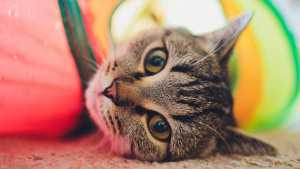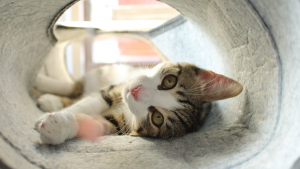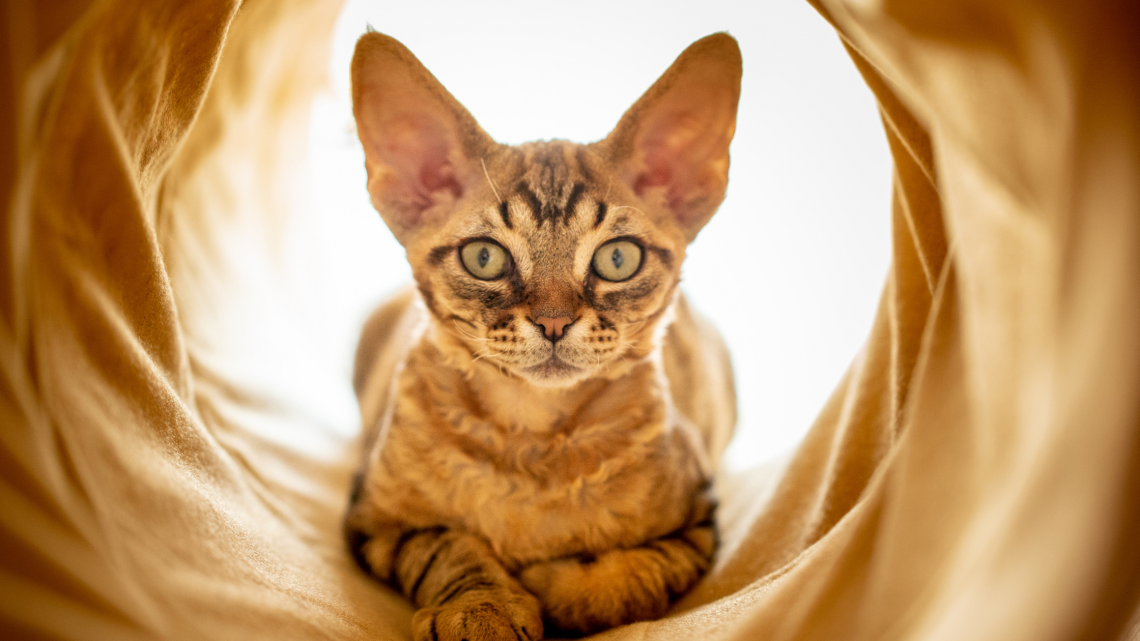At times cats can be mysterious creatures, the way they behave can seem really unusual and realistically a little weird. But that is mostly because we’re putting people’s values onto cats. Cats are a completely different beast and have different needs and wants. Even if they seem domesticated at their core cats are ambush prey hunters. Making use of a cat tunnel is one way they’re feeding this prey hunting desire.
Why do cats like tunnels?
Cats like to find a secluded spot to sit and watch these large lumbering creatures (humans) go about their day. They can perch for hours, and be perfectly entertained by making us drop food into a bowl at the sound of a ‘meow’. However, something that is hard to mimic is the chase of their prey. They live for the joy of sprinting about, or testing they’re best ninja skills on a random piece of fluff. This is where a cat tunnel can add some extra delight into your cat’s life.
Not only can they use a tunnel for prey hunting, but many find the enclosed space relaxing and can sleep in this ‘secluded’ spot for a few extra hours in a day. Cats are curious by nature and a new object placed into a room will feed this insatiable desire to explore and discover. After a few tentative sniffs your cat will likely find a new home in this mysterious object. You may find they tear through it, or simply roll about inside batting casually at any toys strung up inside.
When we think of a tunnel, we most often think of a horizontal object. But cats actually prefer height over length. You can see this in most cat enclosures, in that they are tall rather than wide. Vertical cat tunnels will need to give your cat some means of climbing and this is often done with inbuilt steps or shelves. These types of tunnels are excellent for multiple cat homes, as often each level will be ‘owned’ by a particular cat. Unless you have a bossy cat, then they’ll take over all the levels.

Types of cat tunnels
A cat tunnel can be any object that your cat can fit into and has a hole at each end. Cat tunnels are usually at least half a metre in length, this is good enough to pounce through or for short sprints. However, you can make a cat tunnel as long as you like. If you’re buying a cat tunnel from a retailer, they are often 50-90cm in length. However, you can stitch two together to make a longer tunnel.
Generally, there are two types of tunnels. One purely for playing, and the other as a functional item. If your cat tunnel is mainly for playing, or ‘hunting’, then you’ll have it built into a standard cat scratching post, or laid down on the ground. The other types of tunnel can be used to get your cat from one part of the house to another. Cat owners (parents) can have extravagant setups inside their homes and using tunnels is one way for the cat to get around. You can install resting shelves for your cat up on walls and use tunnels to help them traverse the different levels.
You can also use tunnels outside as a safe means for your cat to get around the garden. This gives them the freedom to explore without being confined to one part of the garden. With cat tunnels, their use and design are only stopped by your imagination.
How to build a cat tunnel?
When you’re building your own cat tunnel, it gives you more freedom in design over the standard cat tunnels you can buy in a store. The first step is to figure out where you’re going to install the cat tunnel. Measure out the distance and then decide what materials you’re going to use. There is a wide choice of materials available, however the most common are cloth, wire, plastic, and wire. To figure out the diameter of the tunnel, you can measure the height of your cat. Even though they can fit in tight spaces, you want to make your cat tunnel at least the height of your cat so they can run through easily and not get caught on the sides of the tunnel.
While cats are reasonably agile, if your tunnels are going to sit at an angle of over forty-five degrees, you may need to include some internal ladder or steps to help your cat climb. If it will be vertical, include interior shelving so they can move up the tunnel to get to the top.
For the main structure of the tunnel you can use many different materials, but the most common one for a home built cat tunnel is wood or wire. Unless you’re a highly skilled wood smith, most wooden tunnels will be square in shape. As they can be quite heavy, wood tunnels are best used either vertically, or as a short bridge between other shelves. The advantage of wood is that you can easily staple carpet to the outside or the inside and provide your cat with a comfortable place to lie down and relax. For the best results we have found that a soft carpet interior and a painted, or varnished, exterior will have the tunnels looking professional and suitable for most home interior decor.
If you decide to use wire, we’d recommend wrapping it around some softer materials such as carpet, hessian, or another sturdy material. The easiest wire to work with is standard fencing wire, most of these come in sizes of 1.2m, but if you want a longer tunnel you can stitch these together. As wire tunnels lack internal support, you may need to install a wooden plank if you wish to use the tunnel off the ground. To attach the materials to the wire, you can either use straight wire, or strong thread and weave it in and out along the length of the tunnel. Make sure there are no gaps that your cat can easily get a foot stuck in, or any wires sticking out into the tunnels that could cause an injury.

The benefits of a cat tunnel
Keeping cats entertained is one of the best ways to make sure they are not doing anything destructive. Bored cats are problematic for most homes, and they can start to entertain themselves. This can result in behaviour that you’d rather not have to contend with such as, eating plants, knocking over random objects, or fighting (if you have more than one cat).
Tunnels can provide your cat with an interesting place to play, and it allows them to play out hunting fantasies. If your cat is an inside cat, then stimulating their natural hunting instincts will keep them happy and healthy. Not only are tunnels a way to keep your cats entertained, but they can be practical as well. If you need a way for your cat to get from one location to another you can use a cat tunnel. This may include stalking about in your garden, or simply getting from one secluded sunny spot to another!


No Comment